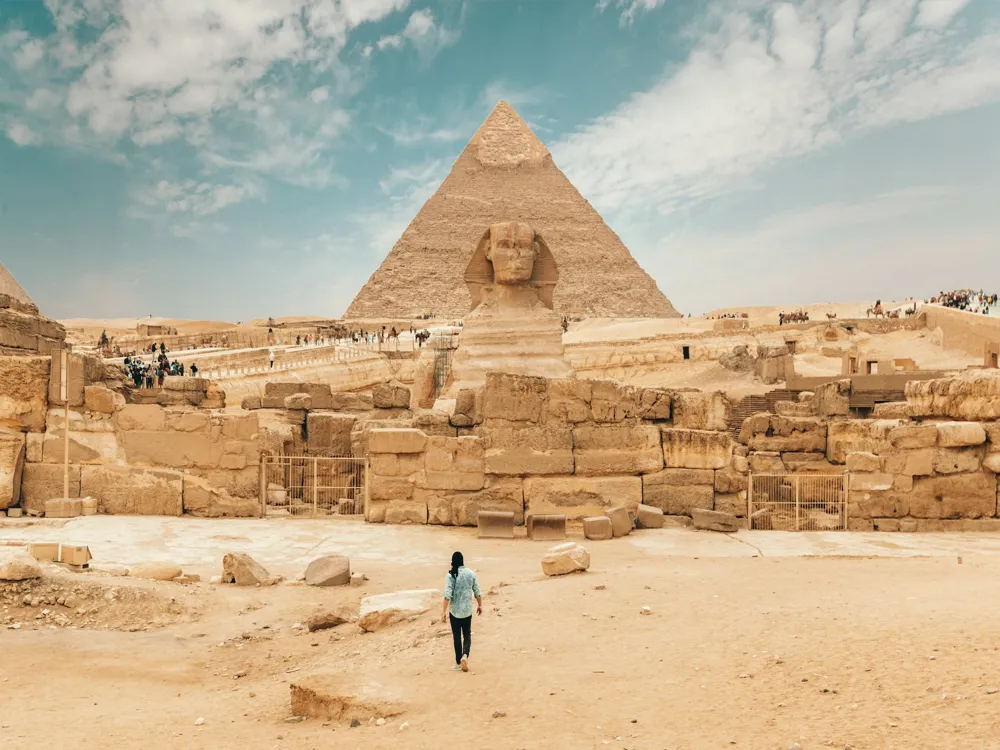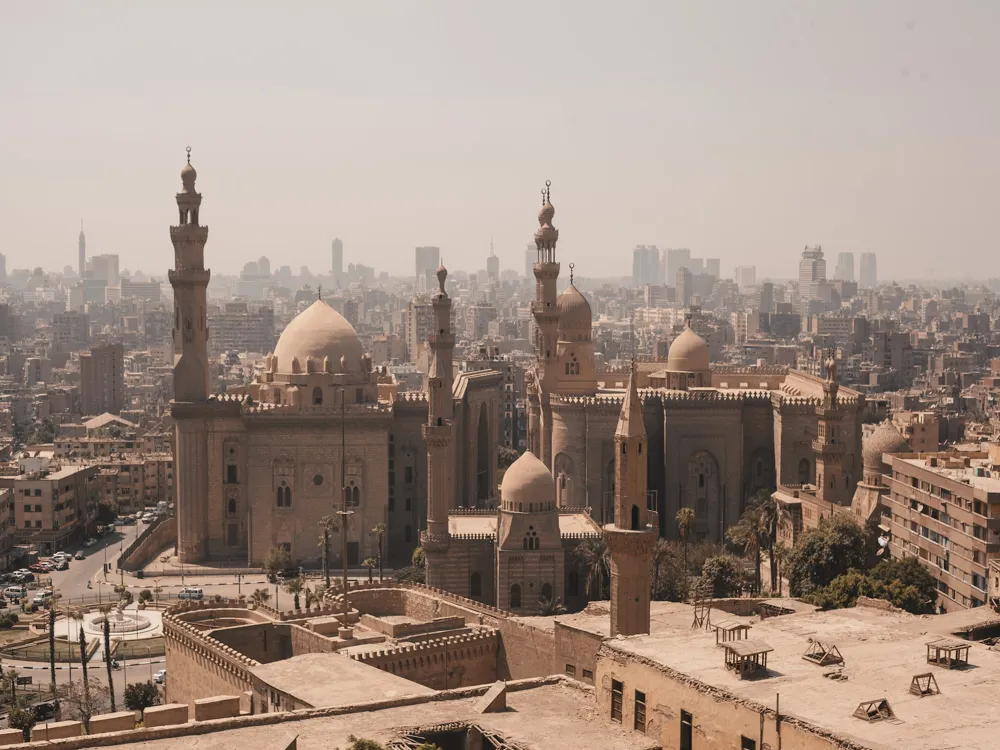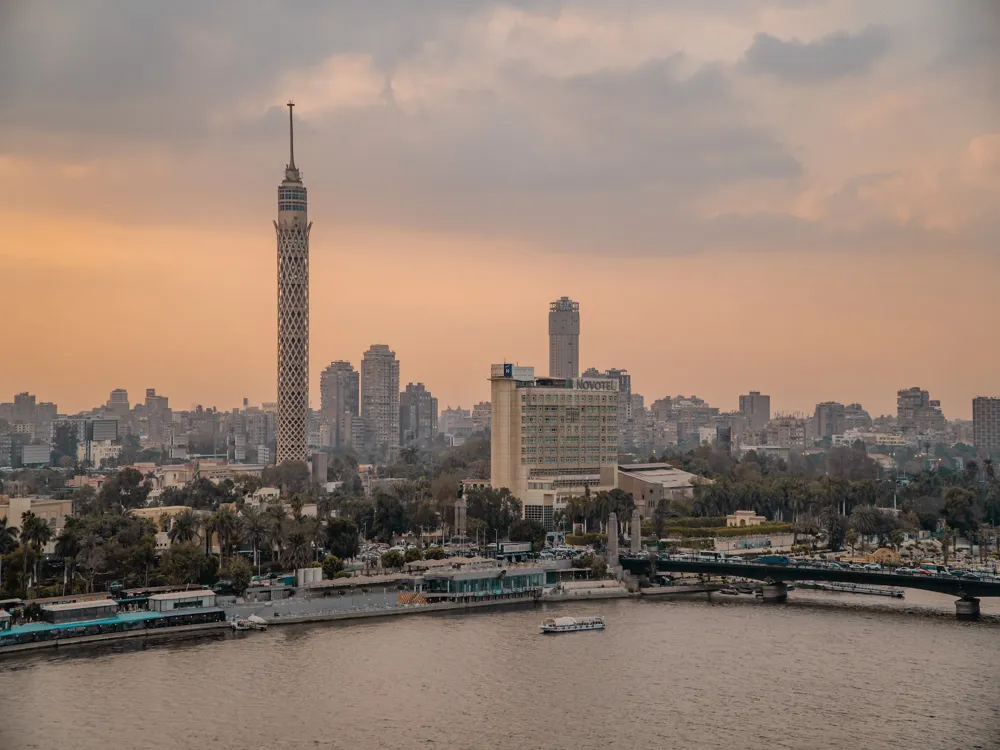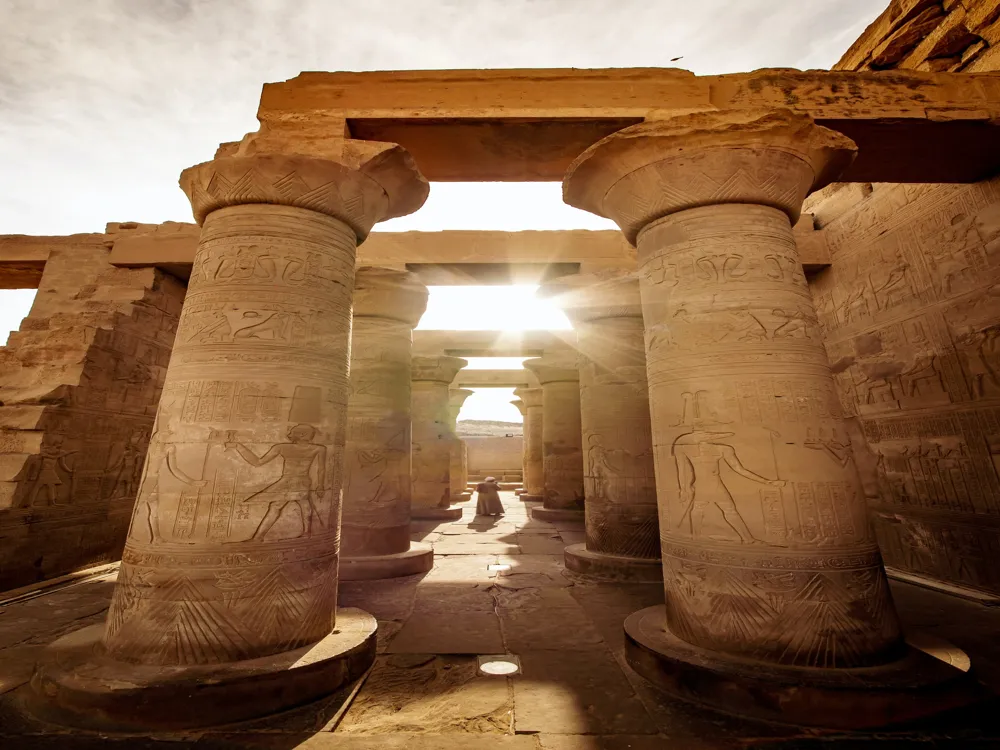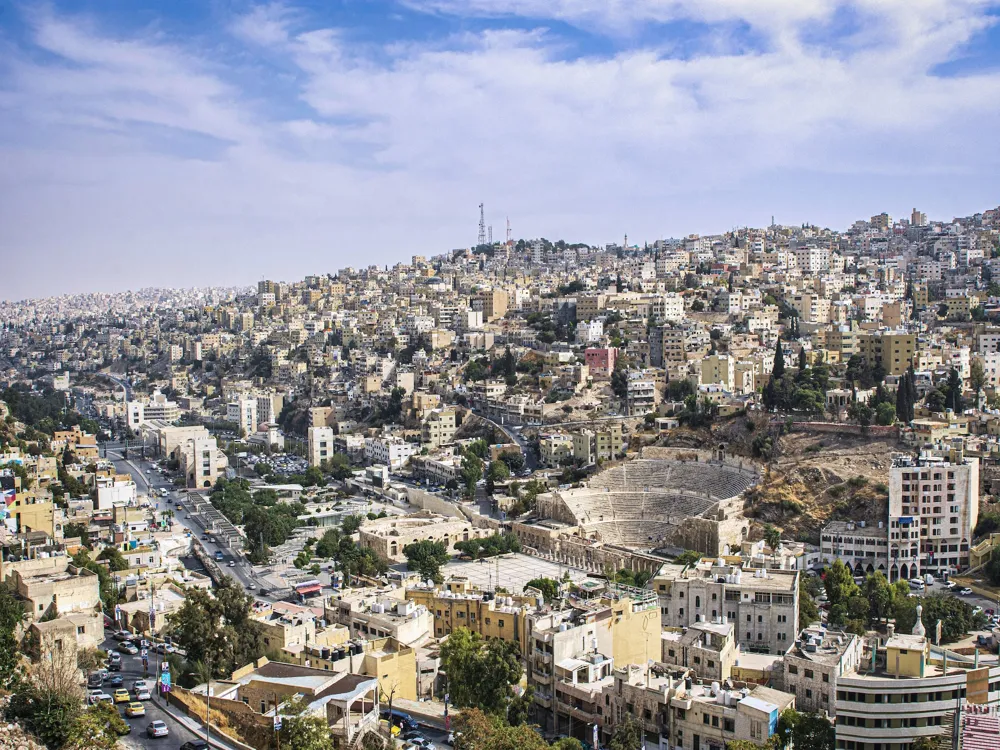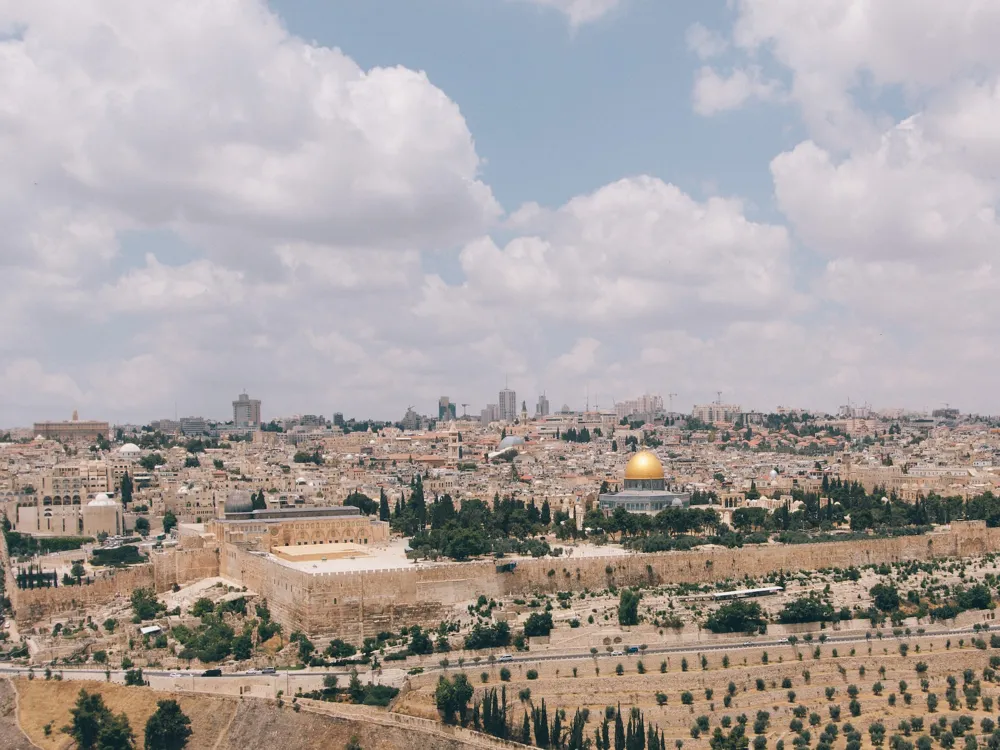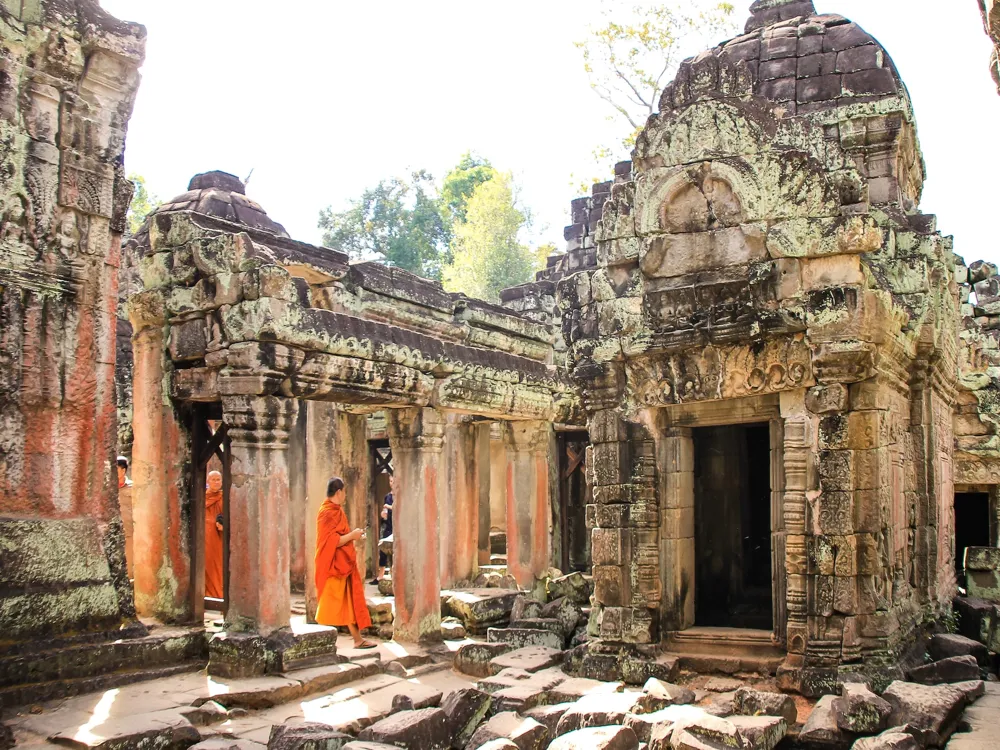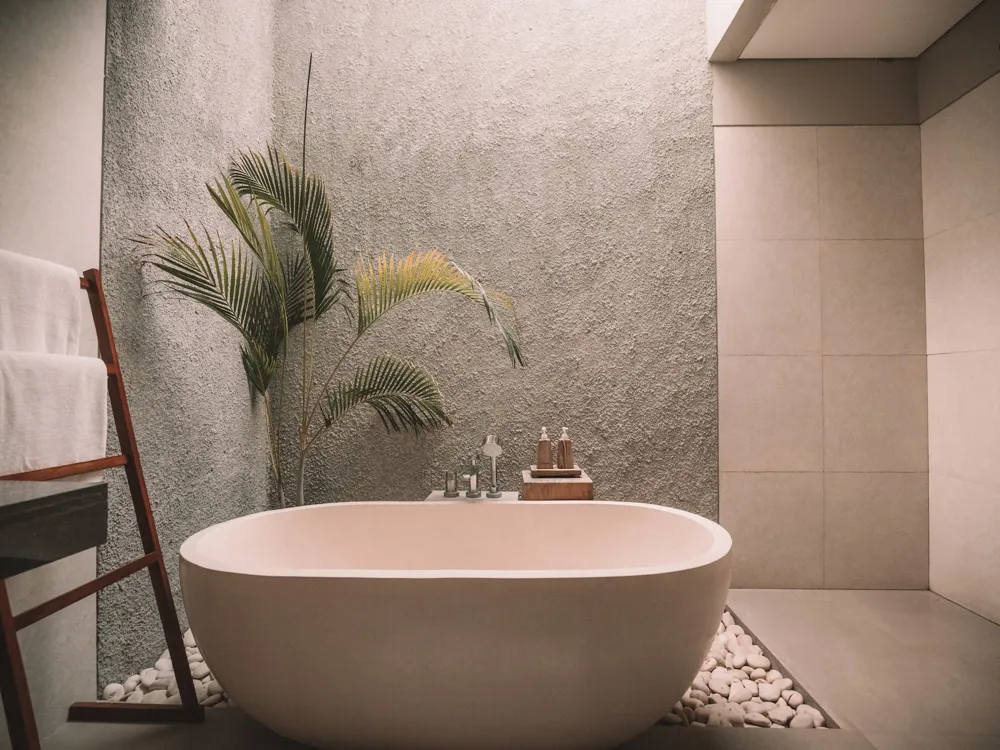Plan Your Travel To Cairo
Places To Visit In Cairo
Al-Azhar Mosque
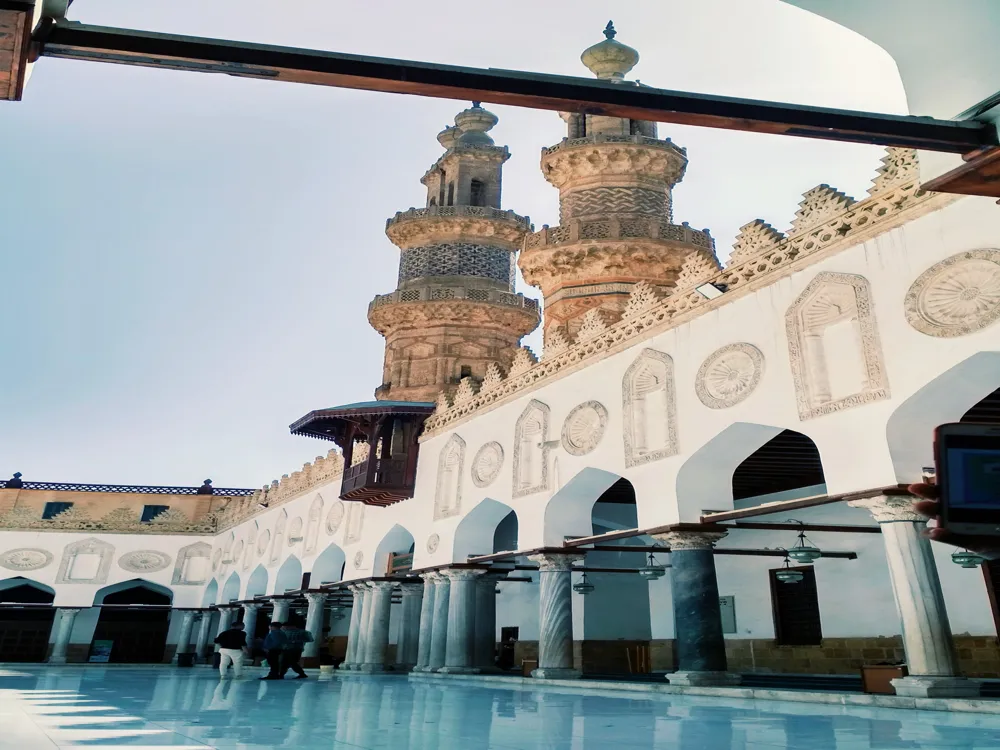
A remarkable establishment, Al-Azhar Mosque is a marvellous building in Cairo. Having been built in AD972, It is really old and one of the prime landmarks in the city. It is also one of the oldest surviving mosques and one of the oldest universities in the world.
The spectacular landmark has a huge primary gateway allowing visitors to enter and explore this marvel's stunning architecture. The five minarets of the mosque are visible from a distance. Visitors often sit inside and pray in the central hall to get some respite from the outer busy world.
Read More
Al-Azhar Park
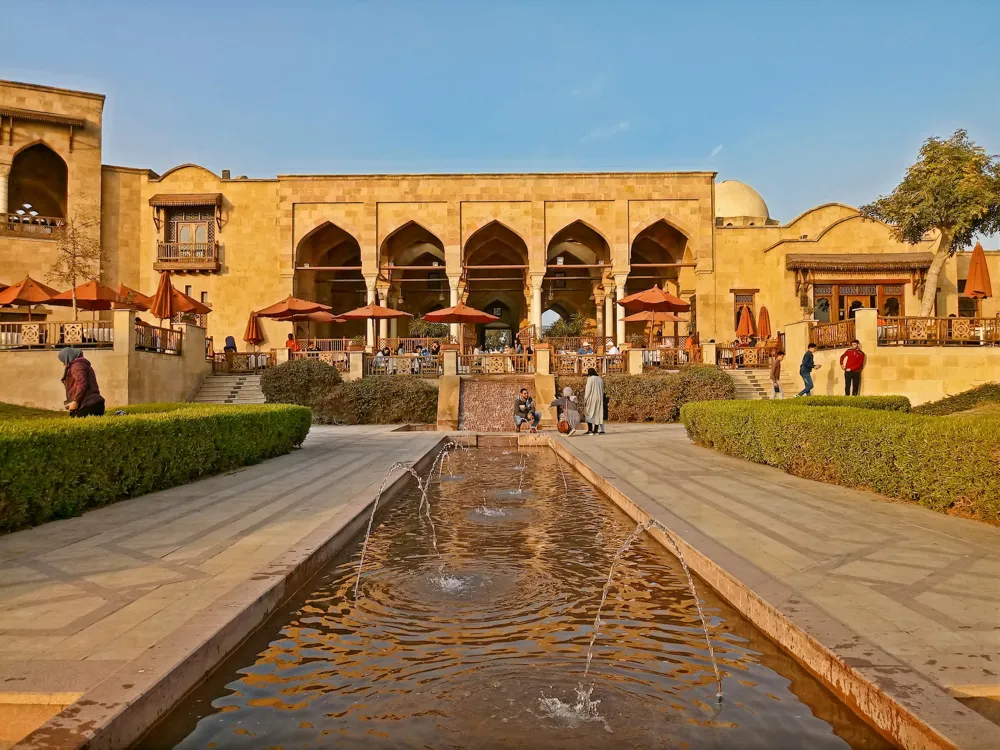
Spread across a sprawling area of 30 hectares, the Al-Azhar Park in Cairo is another place which is going to leave you spellbound with its beauty. The park is surrounded by some of the most historic and significant districts of Cairo city, and is a must visit place for tourists as well as local residents of the city.
Initially existing as a vast dumping site for the city’s garbage back during the 1980s, the city, as well as the Al-Azhar Park has undergone significant transformation. Present day, the park is playing a crucial role in amplifying the panorama of the place.Apart from this, there are multiple parks designed and developed within the Al-Azhar Park. These small parks are home to more than 325 species of plants. Some of these species are native to the soil of Egypt, while some are exotic plants grown and maintained at the park’s nursery.On closely observing the design and landscape planning of the Al-Azhar Park, you will see that the park has been designed in the shape of a tree, with the roots grounding into the Darb al-Ahmar neighborhood nearby. Pinch of modern cultures and traditions blended with the ancient Islamic history is what makes this place a true masterpiece in all senses. All in all, the park is yet another marvellous sight one can get to witness in Cairo.History of Al-Azhar ParkToday, the reason behind the existence of Al-Azhar Park is Agha Khan IV. Moving back to the year of 1984, the present day park used to be a sight of garbage dumping from over half a millennium. Hence, in order to develop a synonym of an oasis in the heart of Cairo city, Agha Khan IV laid the idea of Al-Azhar Park with a whopping budget of around USD 30 million for the same.This challenging task of designing the park was assigned to a local team of architects. That time, they had no idea that what they were going to design would become one of the major tourist attraction of the city, vibrating its popularity across the globe. With the movement of tons of debris out of the park and for landfilling purposes, the park was finally opened for sightseeing to the general public in the year 2005.Since then, the Al-Azhar Park has been fascinating people from all over the world with its beautiful plantations, terraced gardens, water fountains, Mamluk stonework comprising of multi-coloured stones, bold geometry, sunken gardens and what not.The Architecture of the ParkIntriguing architecture is another thing to be observed apart from the magnificence of the park. The Al-Azhar Park is originally situated on the location of garden dating back to the 10th Century AD, i.e. during the Fatamid reconstruction period.One of the marvels of architecture which you will witness while strolling through the park is the ‘spine’, which gets its name because it runs through the centre of the park. The ‘spine’ is a walkway space which follows along the entire length of Al-Azhar Park. While walking along the ‘spine’ walkway, you can easily observe the attractions of the park, which are no less than a visual treat for your eyes.Charming fountain bowls, chadar waterfalls, ground level fountains, rills and small canals, the visual attractions of the place are bound to give you wonderful memories of visiting this park. In addition to this, informal plantations and lush green lawns can also be observed surrounding the ‘spine’ walkway.Not only this, the park has been designed in a manner such that the ponds situated within the park can derive their continuous source of water from the River Nile flowing a few kilometers away from the place. This truly makes the park an architectural marvel in all forms.The overall intent of the designing architects was to integrate the conventional Islamic landscape designing traditions and display it to the world through the greenery and architecture of the park.Out of the many challenges faced during the development of the park, one of the major challenges was the unleashing of around 1.5 km long section of the ancient Ayyubid Wall of Cairo. Dating back to the 12th and 13th Century AD, the excavation works for the wall were processed by workers personally trained by AKTC experts. This further added to the magnetism of Al-Azhar Park.Hence, you are bound to fall in love with the hypnotising beauty and hints of Islamic architecture showcased now and then throughout the Al-Azhar Park. Finally, you can get a 360-degree panoramic view of the ancient Cairo city through the gardens and hilly topography of the Al-Azhar Park.Park LocationAncient districts of Cairo surround the Al-Azhar Park. To the west of the park lies the Fatimid City and the extensions of the place. Along with this, the park is also covered by Darb al-Ahmar serving the tourists and local people its abundant collection of mosques, mausoleums and madrasas.Further, the Al-Azhar Park is covered by the Sultan Hassan Mosque and its nearby localities along with the Ayyubid Citadel. The eastern boundary of the park lies in close proximity to the Mamluk, also known as the “City of the Dead”.Park TimingsSunday to Thursday: 9:00 AM to 10:00 PMFriday and Saturday: 9:00 AM to 11:00 PMHow to Reach Within the CityYou can visit the Al-Azhar Park by either of the modes of transportation mentioned below:CarEither you are a local resident of the place or you are a tourist, you can hop on to a car, or hire a taxi to drive to this beautiful place. To avoid your confusion regarding the entrance of this huge park, you can drive straight to the Salah Salem Street, where the main entrance of the Al-Azhar Park is situated.SubwayThis happens to be one of the cheapest modes of transportation, especially if you are a tourist and are doubtful about the streets of the city. To reach the place by subway, you can board the metro from any part of the city and get down at Bab El-Shaaria metro station.Once you have reached there, the park is at a stone’s throw of roughly 3.6 Kms. to the west of the metro station. You may reach the park from the metro station by booking a taxi or by local transportation modes.BusTo reach the park by Bus, you need to get down at El Darrasa Bus Stop. Once you have arrived there, the main entrance gate of the park lies at a walking distance of 1.3 km to the south of the Bus Stop. This mode of travelling can undoubtedly prove to be a feasible one if you wish to travel via road.Best Time to VisitConsidering the fact that Egypt is an Islamic country, there are chances that the timings of Al-Azhar Park may get changed during major Islamic festivals. In this regard, we would recommend you to avoid going to the park on festival days like Eid.This is because there are chances that the timings of the park may get changed considering the festive season, and we definitely don’t want you to visit the park and find that it will open at a different time that day. Talking about the best time of the year to visit the place, you can go there during the Spring season or the Autumn season, so as to witness the true colours of the place.TipsSo that you can enjoy the beauty of this park, we suggest you pay a visit to Al-Azhar Park during early morning hours, i.e. before noon. This is because the park gets overcrowded with people after 5:00 PM, and hence you won’t be able to enjoy your visit.Interesting FactThe Al-Azhar Park in Cairo has been included in the world’s Sixty great public spaces by the Project for Public Spaces.
Read More
Asfour Crystal Factory

Egypt has always been a home to crystals, stones and gems. The world-famous Asfour Crystal factory has some delightful, imaginative pieces with intricately made crystals. Chandeliers with sparkling and twinkling lights are the highlight. A museum-like room is also attached to the factory, which displays all the greatest works.
Bab al Futuh
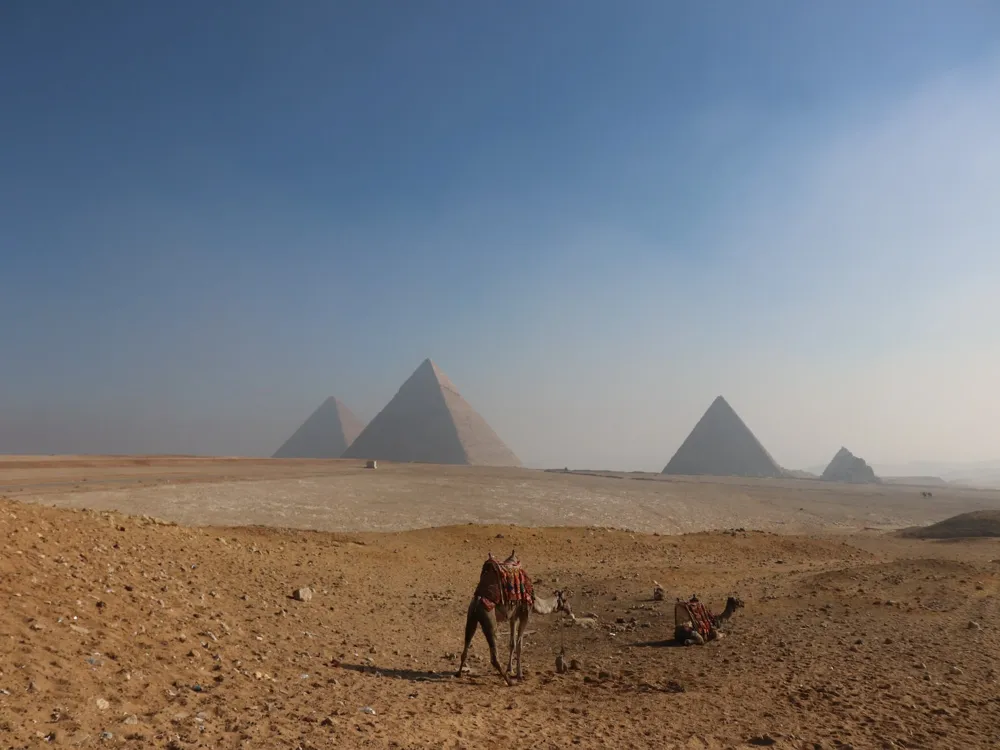
Completed in 1087 A.D., the Bab al Futuh gate situated on the northern end of Muizz Street in Cairo is one of the iconic figures identified in the fortification of the old city of Cairo. While its elegant curved walls showcase its distinct architecture, the same walls also provided a strong defence against enemies during old times.
Bab Zuweila
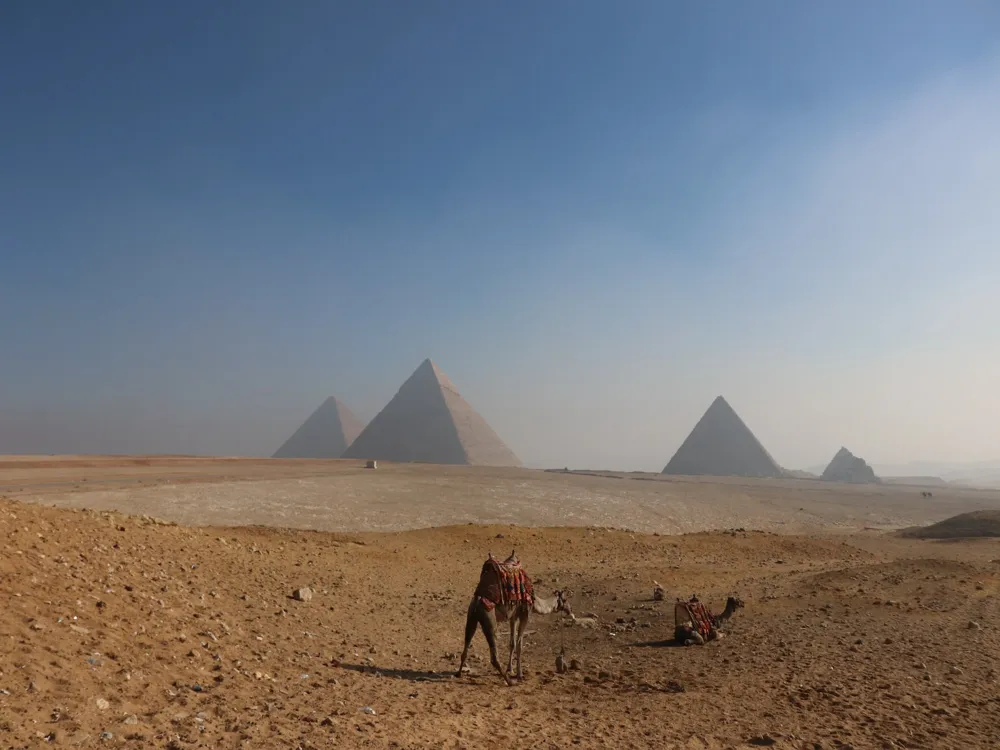
The only surviving southern gate of the city, Bab Zuweila was built in medieval times and served as an entry to the city of Al-Qahira. The spectacularly standing minarets on the gate beautifully depict the architecture of that era. The gate was also popular for being used to execute criminals and prisoners by the rulers of that time. Tourists often enjoy the mesmerising views from the top of this beautiful landmark.
Ben Ezra Synagogue
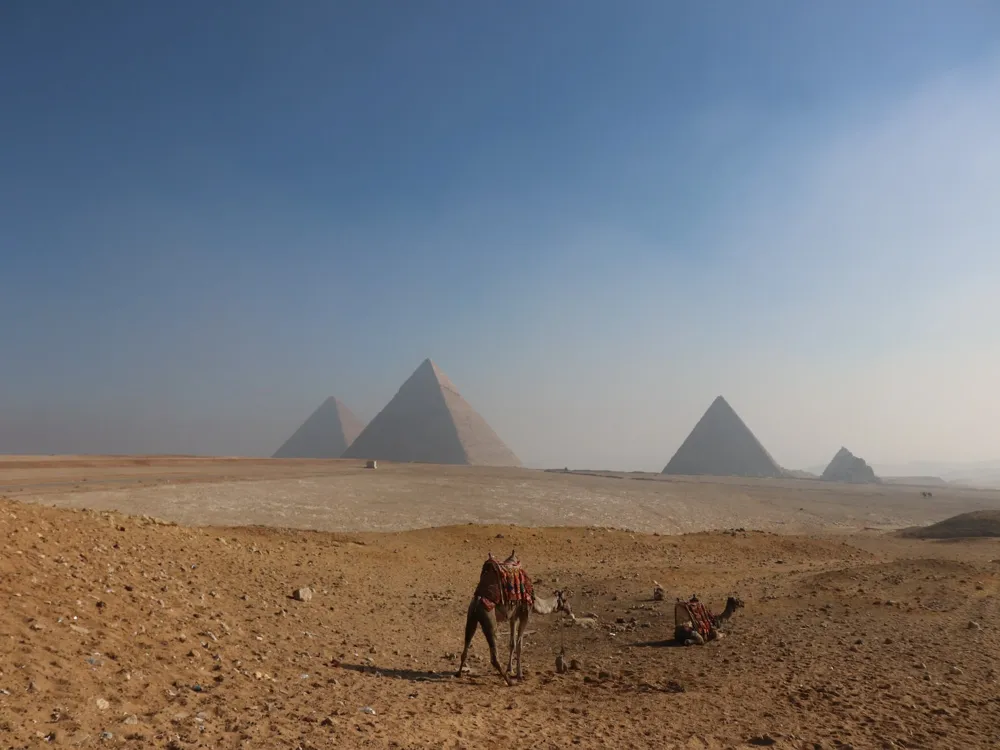
The Ben Ezra Synagogue became a place of worshipping for Jews in 882 AD. Back in the 6th Century AD, the synagogue was a figure of the Jewish revolution, when the prophet Jeremiah gathered all the Jews after Nebuchadnezzar's destruction of the Jerusalem Temple. Situated next to the Hanging Church and the Coptic Museum, it is considered a must-visit destination during the trip to Cairo.
Cairo Tower
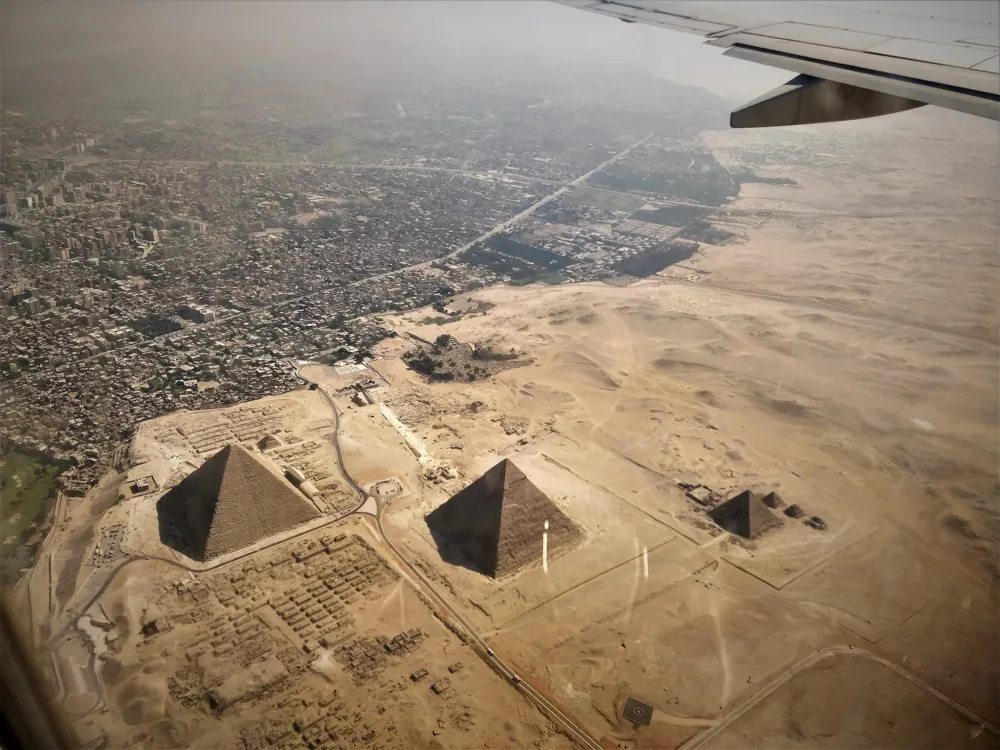
Standing firmly at the height of 187 metres from the ground, the Cairo Tower is situated at Sharia Hadayek Al Zuhreya Gezira. It is known for its design, architecture, and stunning view of Cairo city from the top floor. There is also the Sky Garden cafe here with an observation deck.
Although the land of Pharaohs holds in its name a large number of tourist hotspots, there are chances that you may get confused between which attractions to visit and which to postpone till the next time. Whatever be the reason, the Cairo Tower is and must be on your To-do list when you visit Cairo.The reason why it is strongly recommended to pay a visit to the place is that there are a lot of restaurants within the building. This gives the food loving people another purpose to visit the place and experience the mouth-watering cuisines offered at the restaurants here.And while you are busy wiping clean the dishes of the food, don’t get scared if you feel the floor moving, because that will be the restaurant rotating. Yes, that’s true. The circular platform atop the Cairo Tower makes one complete rotation every 70 minutes. This way, you get to see the view of Cairo City while gobbling up the food and enjoying the decent charm of the place the pharaonic way.
History
Along with the numerous fascinations people have for the place, there is bit of a political and diplomatic history pinned with the name of this place. Originally designed by the architect Naoum Shebib, the construction of the Cairo Tower was carried out in between the years 1954 to 1961.The then president of Egypt, Gamal Abdel Nasser was attempted for bribery by the U.S. government. In order to be on the safer side, the president moved funds accounting to approximately USD 6 million into the Egyptian government’s funds for the construction of Cairo Tower.It is even believed that the location of Cairo Tower has been selected in a manner so as to taunt the U.S government. This is because the tower is visible clearly from the Embassy of the United States, which happens to be situated across the Nile.The Cairo Tower has also undergone restoration sessions between November 2004 and May 2009. The main objective of this restoration was to prepare the tower for its 50th anniversary in April 2011. Since then, the tower stands firmly enough to attract tourists from all over the world.
The Architecture of Cairo Tower
On closely observing the details of the design and architecture of Cairo Tower, one can surely observe the partially opened latticework geometrical design all over the tower. The overall appearance of this design makes it look like a lotus plant, which was considered one of the major iconic symbols back in Ancient Egypt.The top of the ‘Lotus’ design comprises of a rotating deck, which gives a mouth gaping view of Cairo city while rotating slowly. All in all, the building is a masterpiece of architecture and construction and beautifully showcases the Arab craftsmanship and knowledge through its design.
Activities
The place is mostly occupied by expensive yet top-rated restaurants and nightclubs. You can buy the entry fee to the clubs, or dine at your favourite restaurant as per your choice, but as part of a sightseeing activity, the excitement is much more.You can visit the top floor of the Cairo Tower so as to get a view of your lifetime. Situated almost at the centre of Cairo city, the Cairo Tower allows you to have a 360 degrees view of the city, though at its own speed. In case you wish to take the sightseeing thing to the next level, you can grab the telescope devices installed there and zoom into the beauty and magnificence of the city.On focusing to the west direction, one can observe the Pyramids of Giza with the Sahara desert covering the land of Pharaohs beyond them. Further, on moving the scope towards the east, you will get to witness the medieval quarters of the city. This way, you can enjoy the fun of this place up to your hearts’ content.
Nightlife at Cairo Tower
Since the moment you enter the building premises, you will surely feel the aura of the place. Starting from the Ground Floor, the Legends Nightclub plays for your music which will give you goosebumps. Further, the lighting and crowd of the place will boost your stamina to hit the dance floor for sure.Not only this, there are even restaurants and clubs at the tower which organize belly dancing shows for their audience. This way, you can feel the vibes of dance culture of Egypt in a modern way.As you move to the top floor, the view of downtown Cairo gets even better, and the glitter and sparkle of Cairo city is clearly visible from the rotating platform on the top. Your travel diary is guaranteed to get filled for many pages only on the memories you take away from your visit to Cairo Tower.
Entry Fees and Timings
Any adult person needs to pay a minimal amount of EGP 70 as an entrance fee to the place, while there is no fee charged for children. The timings to visit the Cairo Tower are as follows:Monday to Sunday: 9:00 AM to 1:00 AM.Further, it is advised to visit the tower either during early morning or afternoon hours or during late evening hours. This way, you can avoid the excessive crowd at the place and enjoy yourselves.
How to Reach
CarEither you are a local resident of the city or any tourist, you can easily drive your personal car or hire a taxi to the place situated at Sharia Hadayek Al Zuhreya Gezira.SubwayIn order to reach Cairo Tower, you can hop on to the subway and get down at Sadat metro station, which is the closest to the place. From there, you can either hire a taxi for a minimal distance of 2.4 Kms. to the east from the station.
Best Time to Visit
The best time to visit the Cairo Tower is during late evening hours. This is because the atmosphere gets a little bit chilled due to the desert climate, and it becomes very relaxing in the open air.Further, it is advised that in order to experience the fun and thrill of the place, one should visit the place during winter season months. This will help you in maintaining your chill even in the hot atmosphere of the nightclubs and restaurants of Cairo Tower.
Tips
It is advised to wear loose and comfortable clothing while visiting the place during Summers, and proper winter clothing during Winters and Spring season.
Interesting Facts
Cairo Tower has a rotating platform at the top, which completes one rotation every 70 minutes.
Read More
Coptic Museum
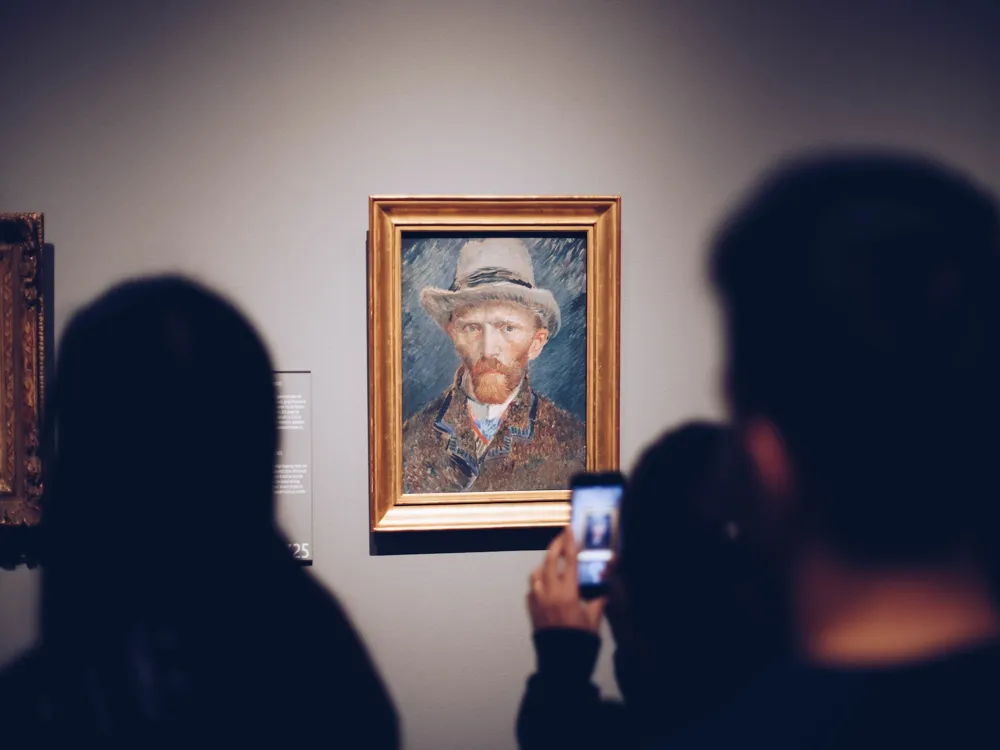
The Coptic Museum holds more than 16,000 artefacts dating back to the presence of Christians in Egypt. Almost all these artefacts have been collected from different monasteries across Egypt. It was founded in 1908.
Upon visiting this ancient museum situated at the site of Babylon, you will find that the artefacts displayed in the museum highlight a connection between the different religions present around the end of Pagan era and the evolution of Christian time period. There is even a museum to enable researchers to delve deeper into the history of the Museum and the Coptic Churches located nearby.The Coptic Museum helps you understand the values and cultures brought to Egypt by Christians. It even showcases artefacts resulting from a mixture of different cultures and communities in Egypt. Along with this, the marvellous architecture of the museum as well as the churches present is another thing which is going to drop down your jaws in admiration. But for that, visit to the Coptic Museum is a must-have thing on your checklist.
History of the Museum
The inauguration of the Museum can be traced back to March 1910, when Marcus Pasha laid the foundation stone of the museum through funds received from the public. The initial artefacts kept on display in the museum were mostly silver antiquities, frescoes, icons and vestments received from Patriarch Cyril V and the Coptic community in Egypt.The success of the museum attracted the Department of Antiquities to take in under its jurisdiction in 1931. The historical artefacts originally kept at the Egyptian Museum, and belonging to the Christian community, were moved to the Coptic Museum in 1939. The moved artefacts were kept for showcase in the new wing of the museum, which got completed in 1944.Since its establishment, the Coptic Museum has undergone several renovations, which were needed mostly due to the damages which occurred to the existing building. The old wing of the museum was shut down in 1966, and the entire museum was renovated during the decade of the 1980s. Since then, further rounds of museum’s renovation took place between 2005 to 2006.After Marcus Pasha, the Coptic Museum received its successors in the form of Dr. Togo Mina, and later Dr. Pahor Labib, who happened to be the first director of the Museum. Even today, the Coptic Museum thrives to reach out to people from different communities of the world, including the Coptic community. With this vision, the museum intends to serve as a platform for sharing experiences and heritage based on Egypt’s Coptic history and to share the same with the rest of the world.
Museum Architecture
Apart from the magnificent artefacts stored within the Coptic Museum, you will find the architecture of the museum compound along with the Churches surrounding it a marvel of architecture.The lush green grounds of the museum give you a sense of peacefulness and solitude, while the architecture of museum building keeps it airy throughout the day. The Museum building is garnished with old mashrabiya screens, with mosaics paved along the way.Along with this, the intriguing architecture of the museum helps you witness the Pharaonic period connected with the Islamic period. The sprinkle of Greek, Roman, Ottoman and Byzantine cultures and traditions into the Ancient Egyptian history can also be witnessed upon visiting the Coptic Museum. All in all, you are going to fall for the beauty of this place for sure.
Notable Artefacts
Out of the many historical artefacts kept for display to the world in Coptic Museum, you will find a wide range of collections and items to sightsee. This includes masterpieces of Stoneworks, Manuscripts, Metalworks, Textiles and Icons dating back to as late as 300 AD.One of such masterpieces to be visited is the Tunic, which is as old as the 5th Century AD. Made up of linen and wool, the tunic has been a garment worn during the Greco-Roman civilization.On closely observing the tunic, you can easily observe an arcade enclosing figures of dancers and warriors. The bottom of the tunic covered with human busts, dancers and warriors highlight the excellence of textile workers of that age.Another artefact which will take you deep into the Coptic history is the icon of Jesus entering Jerusalem as a King. Belonging to the 18th Century AD, the icon has been painted on wood in the Akhmim style. The icon showcases the entry of Jesus as a victorious King in Jerusalem.Talking about the artefact a more, one can observe people lined up in the path, throwing garlands at Jesus and bowing down as Jesus proceeds. The event has been marked as “Palm Sunday”. But to observe such minute details of this masterpiece, you got to pay a visit to the Coptic Museum.
Museum Timings
The Coptic Museum is open at the following timings throughout the weekend:Sunday to Saturday: 9 AM to 4 PM
How to Reach
For you to reach the Coptic Museum in Cairo, you can opt for the following modes of transportation:CarIf you are visiting the city for the first time, you can hop on to a taxi, or rent a car for the day to visit the Coptic Museum situated at #3 Mari Gerges in Old Cairo.SubwayYou can visit the Coptic Museum via subway as well. For this, you need to deboard at Mar Girgis metro station. From the metro station, the Coptic Museum is situated at a mere distance of just 5 meters North of the metro station.So, If you want to whizz past the bustling traffic of Cairo, travelling by metro can be the most feasible option for you to reach the Coptic Museum.
Best Time to Visit
As per the desert climate of Cairo city, the best time to visit the Coptic Museum can be considered in the months between October and April. This way, you can avoid the tormenting heat of Sahara, and have the fun of travelling through the streets of Cairo. While doing so, you can easily peep into the history of Ancient Egypt at the Coptic Museum, and experience the Christian-Egyptian culture.
Tips
Carry a manual describing the artefacts of Coptic Museum. This will help you avoid strolling randomly through the museum when you visit it.
Interesting Fact
The ‘Hanging Church’ of Virgin Mary and ‘The Church of St. Sergius’ situated in Coptic Museum compound are as old as 5th Century AD.
Read More
Eastern Cemetery
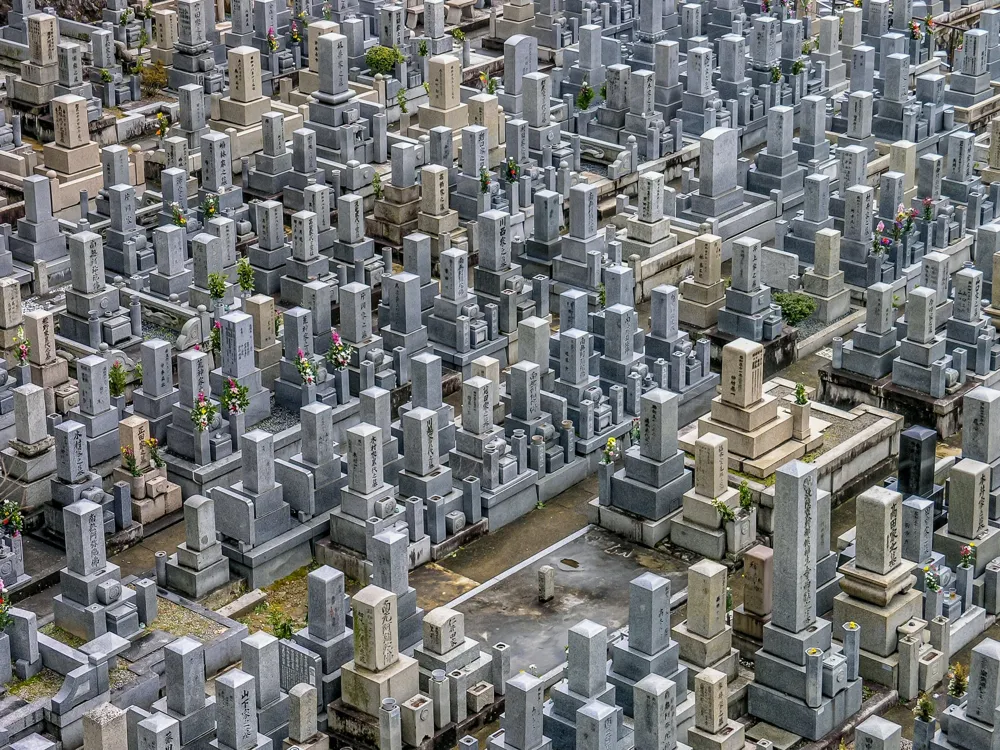
Situated on the eastern side of the Queen’s Pyramids is the Eastern Cemetery of Giza. The Cemetery, being a burial place for most of the members of King Khufu’s family, has been a centre of attraction for the entire world. One of the reasons behind this is the large tomb structures made out of limestone challenging present-day technology. Another reason is the carvings made inside the Mastaba structures. Some of these structures even have multiple rooms inside them.
On your visit to the Eastern Cemetery, one is sure to appreciate and awe at both the architecture and beauty of the place. Although the local authorities have kept some of the tombs closed for public visits since the last few years, the Tomb of Meresankh III and the Tomb of Seshemnufer IV are open for tourists. The walls and the aura of the place speak for itself and the glorious Egyptian Civilization, experiencing which one is sure to jot it down in their travel diaries.
Architecture of Eastern CemeteryThe tombs in the Eastern Cemetery have been arranged in seven rows, each tomb having a different size. The largest Mastaba belongs to Prince Ankh–haf and is located on the north-east corner of the Cemetery. Further, the Tomb of Meresankh III can be found on the eastern side of the place.On the other corner of the Eastern Cemetery, the burial shaft of Queen Hetepheres can be found. The southern portion of the Cemetery contains the Tomb of Seshemnufer IV. The place also consists of other Mastabas and Tombs, such as the Mastaba of Qar, the Tomb of Idu and the Tomb of Nefermaat.Source: https://upload.wikimedia.org/wikipedia/commons/5/5e/Mastabas-est-kh%C3%A9ops.jpgOut of these, only the Tomb of Meresankh III and the Tomb of Seshemnufer IV can be visited from inside. Going inside the Tomb of Meresankh III, one may feel fascinated by the carvings on the walls. Depicting scenarios of daily life from ancient Egypt, such as craftsmanship, farming etc. along with frescoes of Meresankh III’s family are a visual treat for the visitors. Carved deer on the walls of the Tomb of Seshemnufer IV is another thing to be remembered as part of your trip to Cairo.Tomb of QarSituated on the east of the Pyramid of Hetepheres I lies the Mastaba of Qar. Present day, one cannot observe the huge structure of the Mastaba since the structure above the ground got crumbled up to pieces gradually over these years. One may find a flight of stairs going down to an underground hall, where many hieroglyphs can be found. Statues of Qar can also be observed as seated at a table to received offerings from the people.It is believed that Qar was appointed at several critical positions during the Pharaonic period. This includes the position of “Overseer of the Pyramid towns of Khufu and Menkaure”, “Inspector of wab-priests of the Pyramid of Khafre”, and the “Tenant of the Pyramid of Pepy I”. From different events at different stages from the life of Qar to his funeral procession, the walls of the Tomb of Qar showcase everything about one of the key figures of the Egyptian civilization.Tomb of Queen Meresankh IIIOne who was named as the ‘Daughter of the King’, and married to Khafre, the tomb of Queen Meresankh III is a large and beautiful double storey Mastaba, situated south of the huge tomb of Prince Ankh-haf. The entrance stairway of the tomb leads to a large chamber of the tomb which depicts many beautiful rites and rituals performed in the ancient times.Source: https://commons.wikimedia.org/wiki/File:MeresankhII-Sarcophagus_MuseumOfFineArtsBoston.pngOut of the many paintings and illustrations present inside the tomb, people may observe illustrations showcasing many men carving the funerary sarcophagus and the false door for entrance to the tomb. Gold workers can be observed smelting gold and making a palanquin of it. Images of priests or scribes can also be seen on the walls of the tomb. All in all, the place is bound to take you back to the golden days of Egypt by means of the carvings and paintings inside the Tomb.Sightseeing near the Eastern CemeteryPeople visiting the Eastern Cemetery may also spare time and visit the Sphinx as well as the three Pyramids of Giza. If time permits, a trip to the Queen’s Pyramids can also be added to your sightseeing list.Activities to Perform at Eastern CemeteryOne may book themselves a camel ride or horse ride across the premises of the nearby situated Pyramids of Giza and the Sphinx. Locals owning camels and horses can be spotted easily, and you may book your ride for the same by approaching them directly. Bouncing on the double-humped Arabian camels is sure to be one of the most amazing experiences of your lives! If you feel uncomfortable riding the camel, you may hop on to one of the horses and take the ride.Shopping at Eastern CemeteryPeople visiting the Eastern Cemetery can buy different types of souvenirs from the local vendors present near the Cemetery and the Pyramids.How to reach Eastern CemeteryThe only way to reach the Eastern Cemetery is via road transportation. Since the Eastern Cemetery are situated on the outskirts of Giza city, it is advised to reach there either through your personal vehicle or through a taxi/ cab.Tips to RememberCarry plenty of water due to high temperatures during daytime;Wear Sports Shoes;Avoid photography inside the Cemetery;Wear light and comfortable clothing;In case you are a Student, carry your Student ID to avail discount on Entrance Fee.Interesting FactsThe Eastern Cemetery consists of Tombs and Mastabas of key Egyptian ruling families from 4th, 5th and 6th Dynasties.
Read More
Egyptian Museum
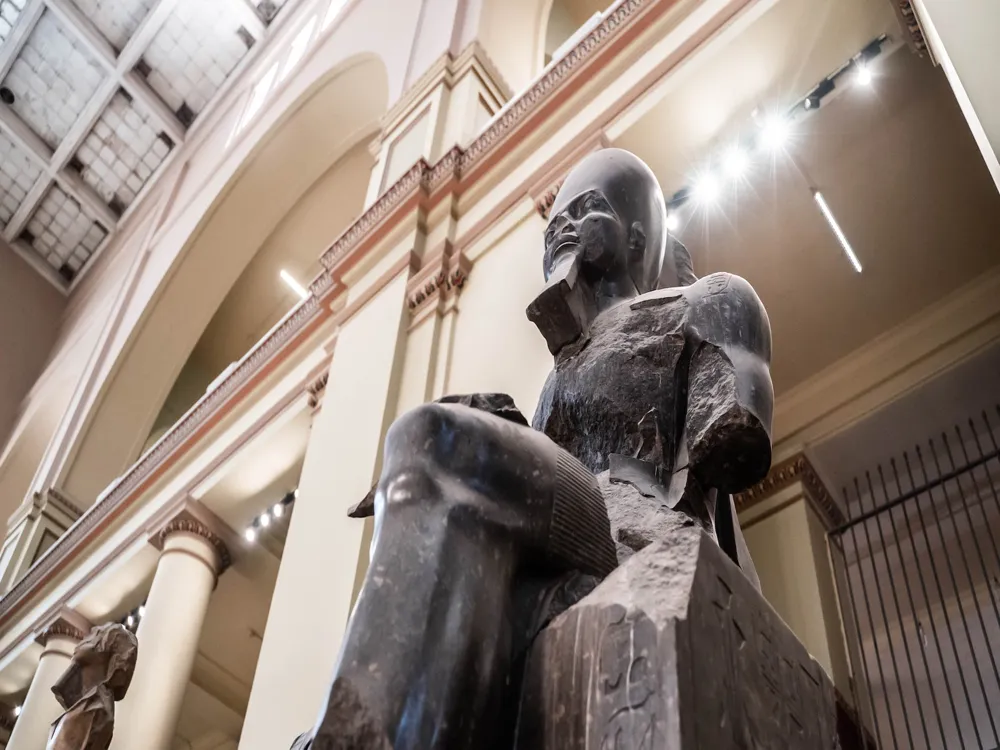
Built in the parts of downtown Cairo, the Egyptian Museum houses some of the rarest and most unique historical artefacts of the time. With a collection of roughly around 120,000 items, the Egyptian Museum is one of the largest museums in the region. It also holds the record of owning the world's largest collection of Pharaonic antiques.
The corridors and halls of the museum building, the gold death mask of Tutankhamun, Mummies, jewellery and many other historical artefacts serve as a medium to give you a sneak peek into one of the golden eras of Egyptian culture and civilisation. To achieve its vision, the Museum of Egyptian Antiquities has ongoing many initiatives for a long time. These initiatives bring together experience, knowledge and ideas from national and international soils, making achieving the objective more comfortable. If you are an enthusiast of history, visiting the museum will give you immense knowledge about the history of Egypt and its rulers.
Museum History
Initially established by the Egyptian government, the Egyptian Museum was set up at Boulaq in the year 1858. This also led to the foundation of the new Antiquities Department. The museum building used to be on the banks of Nile River but suffered huge losses during the flood in the Nile in the year 1878.The artefacts which were restored successfully after the flood were moved to a royal palace in Giza in the year 1891, and were finally moved to the current location of the museum at Tahrir Square in Cairo city.However, the revolution of 2011 led to the damage and destruction of a lot of artefacts and other collected items, including damage to the building as well. Out of the things which got damaged, around 25 were restored, and put on display as part of an exhibition, namely ?Damaged and Restored?. Since then, the museum has displayed
Museum Layout
Once you reach the museum, you will be welcomed by collections and artefacts dating to the period from 1550 to 1069 BC, the New Kingdom. Large statues, coffins, tables, coins and pieces of manuscripts are present right in front of your post clearing the security check. Most of the manuscripts have decayed due to ageing, but the coins are restored very well and are made of gold, silver and bronze.The 1st floor of the building exhibits artefacts from the last two dynasties of Egypt. This includes the collections from the Valley of the Kings and the Tombs of Pharaohs Thutmosis-III, Thutmosis-IV, Amenophis-II and Hatshepsut. The floor displays materials discovered from the intact Tombs of Tutankhamun as well as Psusennes-I as well. These exhibitions are bound to give you a tour of ancient Egypt and the skills owned by artisans of those times.
Noteworthy Artefacts
If you are standing right within the building of Egyptian Museum in Cairo, you ought to visit some of the notable artefacts and collection items present in the museum. You may think of it in the sense that your visit to the museum will be incomplete without seeing the following items:
Gold Death Mask of Tutankhamun
Since the discovery of the Tomb of Tutankhamun in the year 1922, the gold death mask of the young ruler has been preserved with the utmost care over the years. The mask, as well as the Tomb, is a gaping mouth sight in itself, with illustrations of Egyptian gods and goddesses inscribed on the outer walls of the Tomb.After looking at the mask and the Tomb of King Tut, you will be bound to believe the pride taken by Egyptians in their skillset and culture of the time. The death mask of King Tut is especially one of the major attractions of the museum for the visitors, so you are going to find a lot of people buzzing around the gold mask and the Tomb.Inlaid Diadem with Vulture and Cobra UraeusMade up of materials like gold, obsidian, glass, carnelian, malachite, chalcedony and lapis-lazuli, the artefact was discovered from the Tomb of Tutankhamun by famous archaeologist Howard Carter.At the time of discovery, the diadem was worn by the mummy of Tutankhamun. With goddesses Wadjet (Cobra) and Nekhbet (Vulture) in the front, and cobra's tail undulating along the circumference of the diadem, it is an informal crown discovered dating to the Egyptian era.Emblem of AnubisThe upper part of this emblem is made out of wood, and further overlaid with coatings of gilded and gesso. The artefact consists of names of the kings which were given life forever through the epithet ?mry impw imy wt?, which implies the message ?beloved of Anubis who presides over the embalming booth?.The structure represents a pole ending inside a lotus bud, with an animal skin suspended from the pole ending in a papyrus flower. The base of the structure consists of a solid alabaster pot, which holds the pole in a firm position. This artefact was discovered from inside the chamber of the Tomb of Tutankhamun and is a perfect masterpiece of artisanship of Egyptian New Kingdom.
Museum Timings
You can visit the Egyptian Museum on any day of the week, but as per the official timings of the museum for the public. Generally, the Museum timings are:Monday to Wednesday, Friday and Saturday: 9 AM to 5 PMThursday and Sunday: 9 AM to 9 PM
How to Reach
CarIn case you wish to go to the museum by road, you can book a taxi or hire a car for the day. Once you have access to the wheel, all you need to do is to head straight towards the Museum situated at Tahrir Square in Cairo city.SubwayTo reach the Museum via Subway, you need to deboard the metro at Sadat Station. Once you have reached Sadat, the Egyptian Museum lies at a walking distance of 0.4 Km north of the station only. This will save a lot of time from the traffic jams of the city.
Best Time to Visit
The best time to visit the Egyptian Museum is during the spring season. This is because there are chances of snowfall in Cairo during the winter season. As a result of bad weather conditions, the museum is likely to be shut down for temporary time periods. And we don't want to spoil your vacations by suggesting you to go to the museum when it is closed!Besides, we also don't want you to face the tormenting heat of the Sahara during summertime, just for the sake of visiting the museum. Hence, visiting the museum during the beginning months of the year allows you to enjoy the weather as well.
Tips
Carry some books containing the history of the artefacts placed in the museum. This will help you select which artefacts and items you want to visit first in the museum as per your interest.
Interesting Fact
The Egyptian Museum exhibits the famous Gold Death Mask of Tutankhamun.
Read More
Cairo Travel Packages
View All Travel Packages Cairo
Nearby Places Cairo
Browse Package Collections
Browse Hotel Collections











